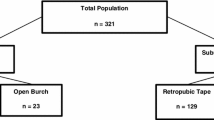Abstract
The objective of the study was to determine preoperative factors (symptoms, history, clinical findings, urodynamic factors or operative findings) associated with voiding difficulties following colposuspension. This retrospective review was undertaken at a urogynaecological clinic in a large district general hospital. Fifty-one patients who had undergone colposuspension for genuine stress incontinence were included. Voiding difficulty was the main outcome measure. This was assessed by time of spontaneous voiding and time of catheter removal. Age was associated with postoperative voiding difficulty when this was assessed by time of catheter removal (P<0.02) and by time of spontaneous voiding (P<0.05). A low preoperative maximum voiding pressure was associated with delayed spontaneous voiding (P<0.05) but not with prolonged catheterization. It was concluded that older patients were at greater risk of voiding difficulty following colposuspension and that HRT did not prevent this complication.
Similar content being viewed by others
References
Hertogs K, Stanton SL. Mechanism of urinary continence after colposuspension: barrier studies.Br J Obstet Gynaecol 1985;92:1184–1188
Stanton SL. Surgical management of urethral sphincter incompetence.Clin Obstet Gynecol 1990;33:346–357
Cardozo LD, Stanton SL, Williams JE. Detrusor instability following surgery for genuine stress incontinence.Br J Urol 1979;51:204–207
Vierhout ME, Mulder AFP. De novo detrusor instability after Burch colposuspension.Acta Obstet Gynecol Scand 1992;71:414–416
Burch JC. Urethrovaginal fixation to Cooper's ligament for correction of stress incontinence, cytocele and prolapse.Am J Obstet Gynecol 1961;81:281–290.
Lose G, Jorgensen L, Mortensen SO, Molsted-Pedersen L, Kristensen JK. Voiding difficulties after colposuspension.Obstet Gynecol 1987;69:33–38
Stanton SL, Cardozo L, Chaudury N. Spontaneous voiding after surgery for urinary incontinence.Br J Obstet Gynaecol 1978;85:149–152
Norton P, Stanton SL. Isometric detrusor tests — a predictor of post-operative voiding difficulties. In: Proceedings of the eighteenth annual meeting of the International Continence Society.Neurourol Urodyn 1988;7:287–288
Stanton SL. Voiding difficulties. In: Shaw R, Soutter P, Stanton S, eds. Gynaecology. Edinburgh: Churchill Livingstone 1992: 647–652
Dundas D, Hilton P, Williams JE, Stanton SL. Aetiology of voiding difficulties post colposuspension. In: Proceedings of the twelfth annual meeting of the International Continence Society 1982, Leyden, p 132
Bhatia NN, Bergman A. Use of preoperative uroflowmetry and simultaneous urethrocystometry for predicting risk of prolonged postoperative bladder drainage.Urology 1986;28:440–445
Abrams P, Blaivas JG, Stanton SL, Andersen JT. The standardisation of terminology of lower urinary tract function.Int Urogynecol J 1990;1:45–58
Stanton SL: Colposuspension. In: Stanton SL, Tanagho EA, eds. Surgery for female incontinence 2nd edn. Berlin: Springer Verlag 1986:95–103
Massey JA, Abrams PH. Obstructed voiding in the female.Br J Urol 1988;61:36–39
Hilton P. A clinical and urodynamic study comparing the Stamey bladder neck suspension and suburethral sling procedures in the treatment of genuine stress incontinence.Br J Obstet Gynaecol 1989;96:213–220
Hilton P, Mayne CJ. The Stamey endoscopic bladder neck suspension: a clinical and urodynamic investigation, including actuarial follow-up over four years.Br J Obstet Gynecol 1991;98:1141–1149
Parys BT, Haylen BT, Hutton L, Parsons KF. The effects of simple hysterectomy on vesicourethral function.Br J Urol 1989;64:594–599
Kelly MJ, Zimmern PE, Leach GE. Complications of bladder neck suspension procedures.Urol Clin North Am 1991;18:339–348
Roberts M, Smith P. Non malignant obstruction of the female urethra.Br J Urol 1968;90:694–702.
Smith P. Age changes in the female urethra.Br J Urol 1972;44:667–676
Elbadawi A, Subbarao VY, Resnick NM. Structural basis of geriatric voiding dysfunction. I. Methods of a prospective ultrastructural/urodynamic study and an overview of the findings.J Urol 1993;150:1650–1656
Iosif CS, Batra S, Ek A, Astedt B. Estrogen receptors in the human female lower urinary tract.Am J Obstet Gynecol 1981;141:817–820
Elia G, Bergman A. Estrogen effects on the urethra: beneficial effects in women with genuine stress incontinence.Obstet Gynecol Surv 1993;48:509–517
Author information
Authors and Affiliations
Additional information
EDITORIAL COMMENT: Factors which definitively predict those patients who will be subjected to prolonged catheterization after incontinence surgery are currently unknown. Age is known to be a factor, as is confirmed by this study, and previously low voiding pressure was also determined to be such a factor [11] and also has been confirmed here. A big factor which has not been addressed in the literature is the effect of the degree of elevation of the vesical neck by the surgical procedure, and its effects on voiding difficulty. It would seem reasonable to assume that a patient with a higher vesical neck and a Q-tip test approximating −30° from the horizontal would void less freely and later than one with a Q-tip test of +10° from the horizontal. It has, however, been this editor's clinical experience that there is no relationship of this ‘anatomy factor’ to ultimate time of catheter removal. Studies would provide a great deal of information if the degree of elevation of the vesical neck was controlled and accounted for in the analysis of data.
Rights and permissions
About this article
Cite this article
Kremer, C.C., Freeman, R.M. Which patients are at risk of voiding difficulty immediately after colposuspension?. Int Urogynecol J 6, 257–261 (1995). https://doi.org/10.1007/BF01901519
Issue Date:
DOI: https://doi.org/10.1007/BF01901519




